L&D Needs Assessment: Organizational Dependency and ROI Analysis
VerifiedAdded on 2023/06/14
|13
|3909
|210
Report
AI Summary
This report discusses methods for assessing learning and development (L&D) needs within organizations, emphasizing the importance of aligning L&D initiatives with organizational goals and strategies. It covers various assessment methods, including organizational analysis, performance analysis, cost-benefit analysis, content analysis, and trend analysis. The report highlights the organizational dependency of L&D, using TESCO and MORRISON as examples to illustrate how different organizational structures and market positions influence L&D needs. It also examines the impacts of L&D on return on investment (ROI), noting that while L&D can significantly improve profitability, the specific impact varies depending on the organization's stage of development and chosen assessment methods. The report concludes that a thorough understanding of organizational characteristics is crucial for effective L&D assessment and implementation.
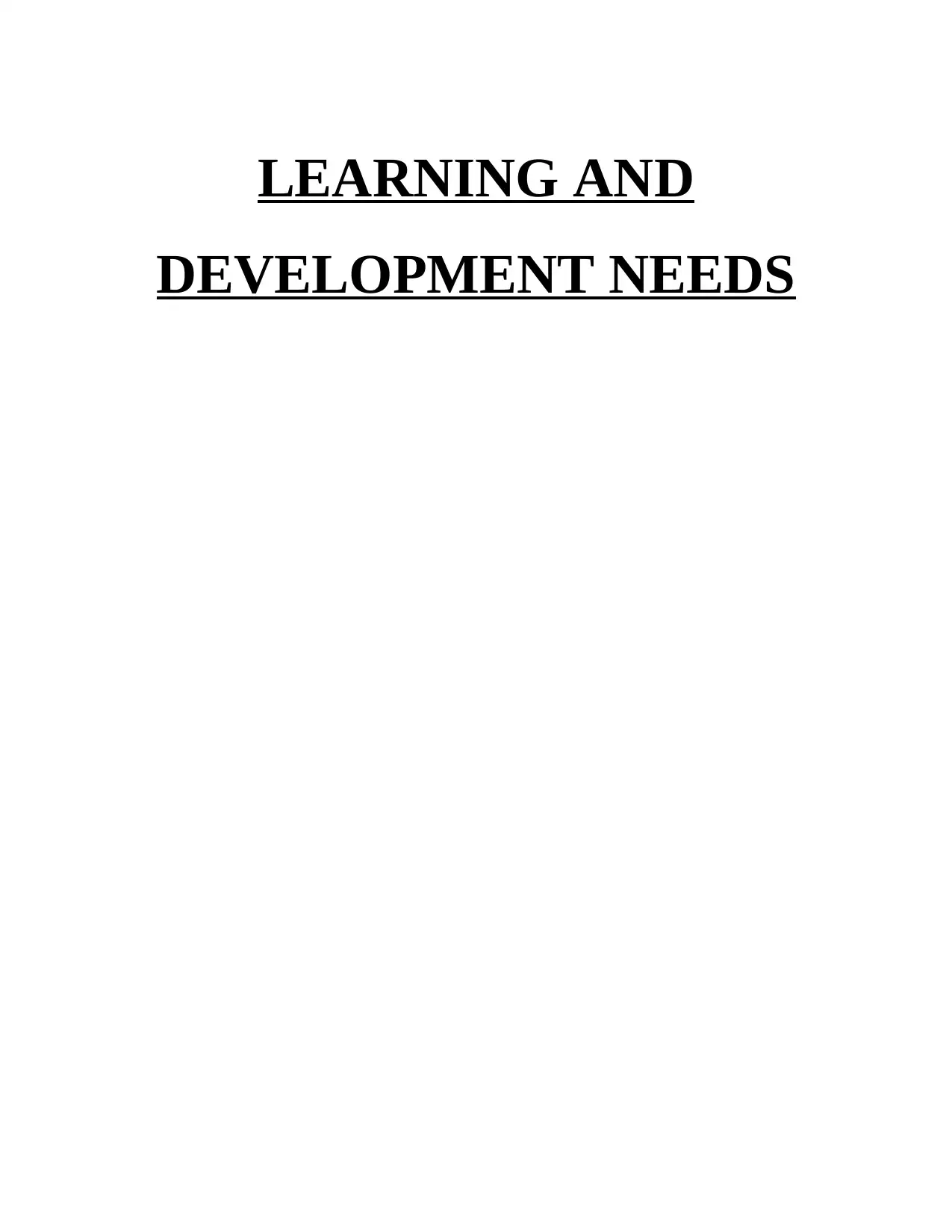
LEARNING AND
DEVELOPMENT NEEDS
DEVELOPMENT NEEDS
Paraphrase This Document
Need a fresh take? Get an instant paraphrase of this document with our AI Paraphraser
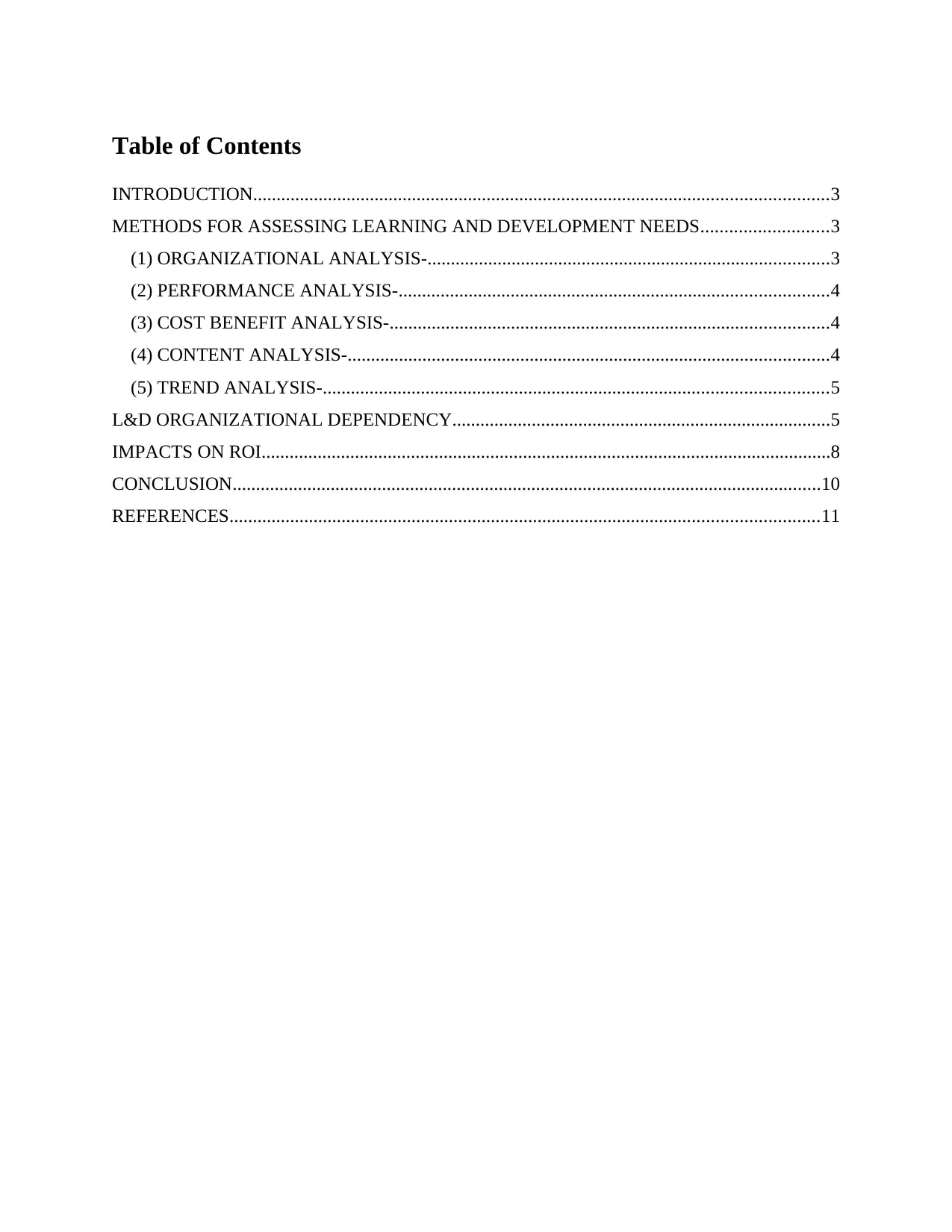
Table of Contents
INTRODUCTION...........................................................................................................................3
METHODS FOR ASSESSING LEARNING AND DEVELOPMENT NEEDS...........................3
(1) ORGANIZATIONAL ANALYSIS-......................................................................................3
(2) PERFORMANCE ANALYSIS-............................................................................................4
(3) COST BENEFIT ANALYSIS-..............................................................................................4
(4) CONTENT ANALYSIS-.......................................................................................................4
(5) TREND ANALYSIS-............................................................................................................5
L&D ORGANIZATIONAL DEPENDENCY.................................................................................5
IMPACTS ON ROI..........................................................................................................................8
CONCLUSION..............................................................................................................................10
REFERENCES..............................................................................................................................11
INTRODUCTION...........................................................................................................................3
METHODS FOR ASSESSING LEARNING AND DEVELOPMENT NEEDS...........................3
(1) ORGANIZATIONAL ANALYSIS-......................................................................................3
(2) PERFORMANCE ANALYSIS-............................................................................................4
(3) COST BENEFIT ANALYSIS-..............................................................................................4
(4) CONTENT ANALYSIS-.......................................................................................................4
(5) TREND ANALYSIS-............................................................................................................5
L&D ORGANIZATIONAL DEPENDENCY.................................................................................5
IMPACTS ON ROI..........................................................................................................................8
CONCLUSION..............................................................................................................................10
REFERENCES..............................................................................................................................11
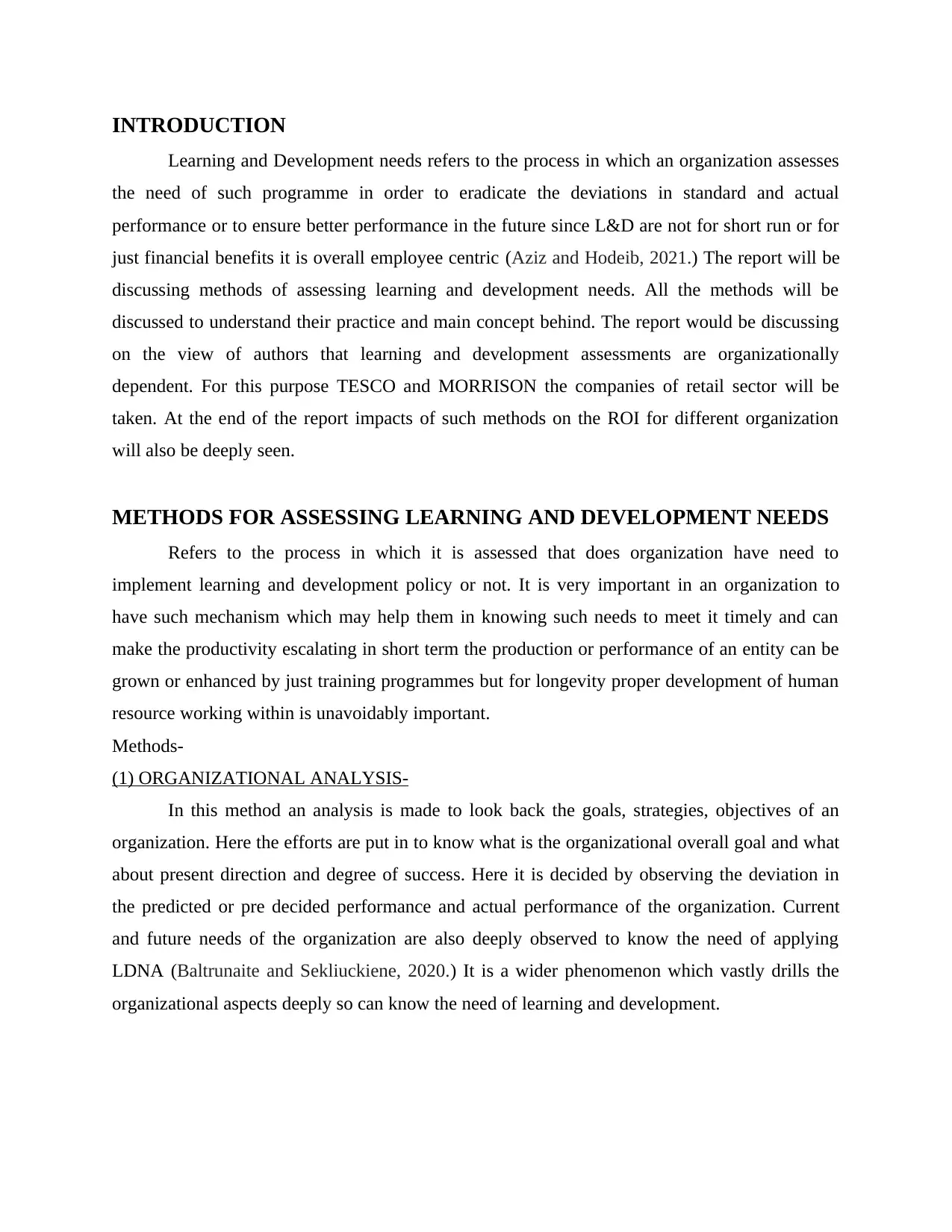
INTRODUCTION
Learning and Development needs refers to the process in which an organization assesses
the need of such programme in order to eradicate the deviations in standard and actual
performance or to ensure better performance in the future since L&D are not for short run or for
just financial benefits it is overall employee centric (Aziz and Hodeib, 2021.) The report will be
discussing methods of assessing learning and development needs. All the methods will be
discussed to understand their practice and main concept behind. The report would be discussing
on the view of authors that learning and development assessments are organizationally
dependent. For this purpose TESCO and MORRISON the companies of retail sector will be
taken. At the end of the report impacts of such methods on the ROI for different organization
will also be deeply seen.
METHODS FOR ASSESSING LEARNING AND DEVELOPMENT NEEDS
Refers to the process in which it is assessed that does organization have need to
implement learning and development policy or not. It is very important in an organization to
have such mechanism which may help them in knowing such needs to meet it timely and can
make the productivity escalating in short term the production or performance of an entity can be
grown or enhanced by just training programmes but for longevity proper development of human
resource working within is unavoidably important.
Methods-
(1) ORGANIZATIONAL ANALYSIS-
In this method an analysis is made to look back the goals, strategies, objectives of an
organization. Here the efforts are put in to know what is the organizational overall goal and what
about present direction and degree of success. Here it is decided by observing the deviation in
the predicted or pre decided performance and actual performance of the organization. Current
and future needs of the organization are also deeply observed to know the need of applying
LDNA (Baltrunaite and Sekliuckiene, 2020.) It is a wider phenomenon which vastly drills the
organizational aspects deeply so can know the need of learning and development.
Learning and Development needs refers to the process in which an organization assesses
the need of such programme in order to eradicate the deviations in standard and actual
performance or to ensure better performance in the future since L&D are not for short run or for
just financial benefits it is overall employee centric (Aziz and Hodeib, 2021.) The report will be
discussing methods of assessing learning and development needs. All the methods will be
discussed to understand their practice and main concept behind. The report would be discussing
on the view of authors that learning and development assessments are organizationally
dependent. For this purpose TESCO and MORRISON the companies of retail sector will be
taken. At the end of the report impacts of such methods on the ROI for different organization
will also be deeply seen.
METHODS FOR ASSESSING LEARNING AND DEVELOPMENT NEEDS
Refers to the process in which it is assessed that does organization have need to
implement learning and development policy or not. It is very important in an organization to
have such mechanism which may help them in knowing such needs to meet it timely and can
make the productivity escalating in short term the production or performance of an entity can be
grown or enhanced by just training programmes but for longevity proper development of human
resource working within is unavoidably important.
Methods-
(1) ORGANIZATIONAL ANALYSIS-
In this method an analysis is made to look back the goals, strategies, objectives of an
organization. Here the efforts are put in to know what is the organizational overall goal and what
about present direction and degree of success. Here it is decided by observing the deviation in
the predicted or pre decided performance and actual performance of the organization. Current
and future needs of the organization are also deeply observed to know the need of applying
LDNA (Baltrunaite and Sekliuckiene, 2020.) It is a wider phenomenon which vastly drills the
organizational aspects deeply so can know the need of learning and development.
⊘ This is a preview!⊘
Do you want full access?
Subscribe today to unlock all pages.

Trusted by 1+ million students worldwide
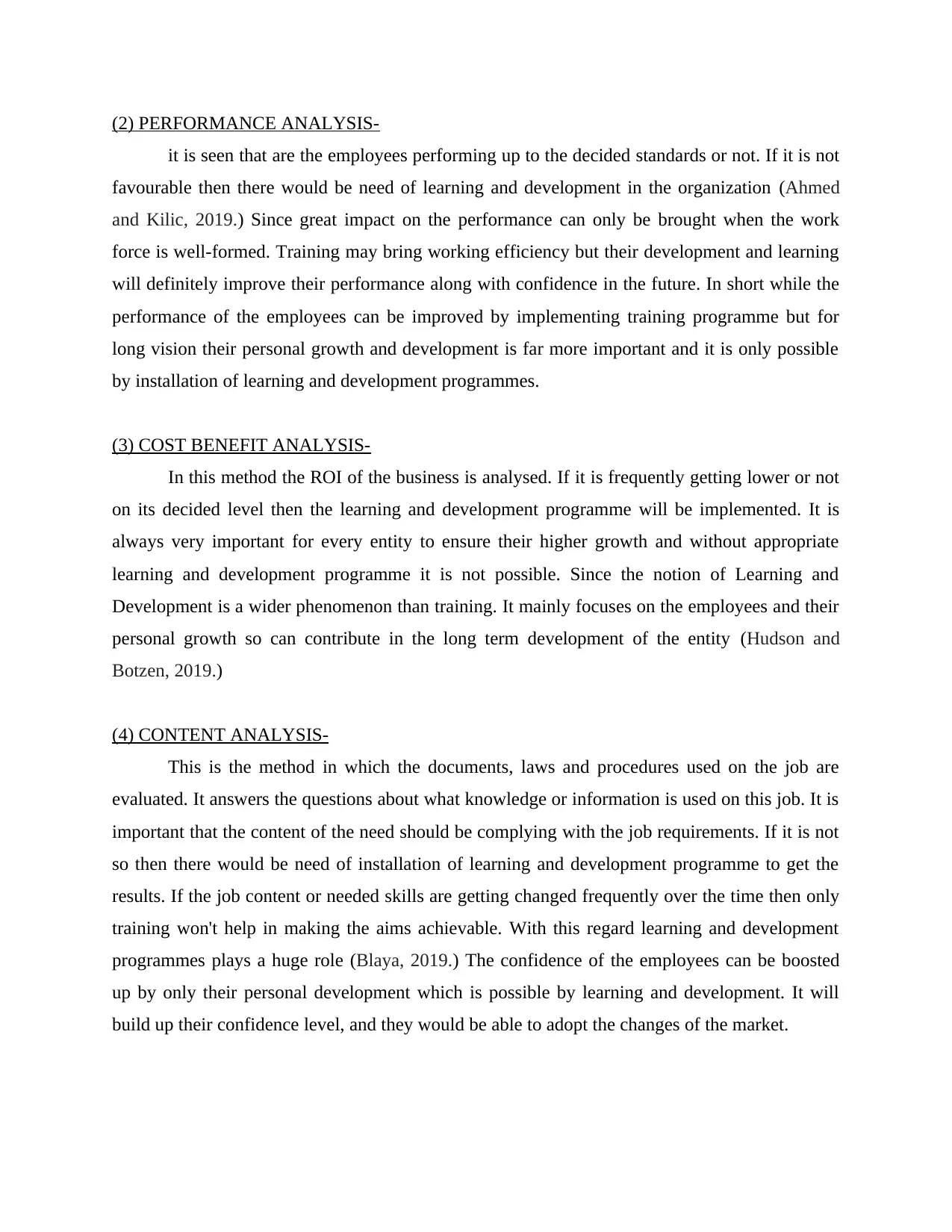
(2) PERFORMANCE ANALYSIS-
it is seen that are the employees performing up to the decided standards or not. If it is not
favourable then there would be need of learning and development in the organization (Ahmed
and Kilic, 2019.) Since great impact on the performance can only be brought when the work
force is well-formed. Training may bring working efficiency but their development and learning
will definitely improve their performance along with confidence in the future. In short while the
performance of the employees can be improved by implementing training programme but for
long vision their personal growth and development is far more important and it is only possible
by installation of learning and development programmes.
(3) COST BENEFIT ANALYSIS-
In this method the ROI of the business is analysed. If it is frequently getting lower or not
on its decided level then the learning and development programme will be implemented. It is
always very important for every entity to ensure their higher growth and without appropriate
learning and development programme it is not possible. Since the notion of Learning and
Development is a wider phenomenon than training. It mainly focuses on the employees and their
personal growth so can contribute in the long term development of the entity (Hudson and
Botzen, 2019.)
(4) CONTENT ANALYSIS-
This is the method in which the documents, laws and procedures used on the job are
evaluated. It answers the questions about what knowledge or information is used on this job. It is
important that the content of the need should be complying with the job requirements. If it is not
so then there would be need of installation of learning and development programme to get the
results. If the job content or needed skills are getting changed frequently over the time then only
training won't help in making the aims achievable. With this regard learning and development
programmes plays a huge role (Blaya, 2019.) The confidence of the employees can be boosted
up by only their personal development which is possible by learning and development. It will
build up their confidence level, and they would be able to adopt the changes of the market.
it is seen that are the employees performing up to the decided standards or not. If it is not
favourable then there would be need of learning and development in the organization (Ahmed
and Kilic, 2019.) Since great impact on the performance can only be brought when the work
force is well-formed. Training may bring working efficiency but their development and learning
will definitely improve their performance along with confidence in the future. In short while the
performance of the employees can be improved by implementing training programme but for
long vision their personal growth and development is far more important and it is only possible
by installation of learning and development programmes.
(3) COST BENEFIT ANALYSIS-
In this method the ROI of the business is analysed. If it is frequently getting lower or not
on its decided level then the learning and development programme will be implemented. It is
always very important for every entity to ensure their higher growth and without appropriate
learning and development programme it is not possible. Since the notion of Learning and
Development is a wider phenomenon than training. It mainly focuses on the employees and their
personal growth so can contribute in the long term development of the entity (Hudson and
Botzen, 2019.)
(4) CONTENT ANALYSIS-
This is the method in which the documents, laws and procedures used on the job are
evaluated. It answers the questions about what knowledge or information is used on this job. It is
important that the content of the need should be complying with the job requirements. If it is not
so then there would be need of installation of learning and development programme to get the
results. If the job content or needed skills are getting changed frequently over the time then only
training won't help in making the aims achievable. With this regard learning and development
programmes plays a huge role (Blaya, 2019.) The confidence of the employees can be boosted
up by only their personal development which is possible by learning and development. It will
build up their confidence level, and they would be able to adopt the changes of the market.
Paraphrase This Document
Need a fresh take? Get an instant paraphrase of this document with our AI Paraphraser
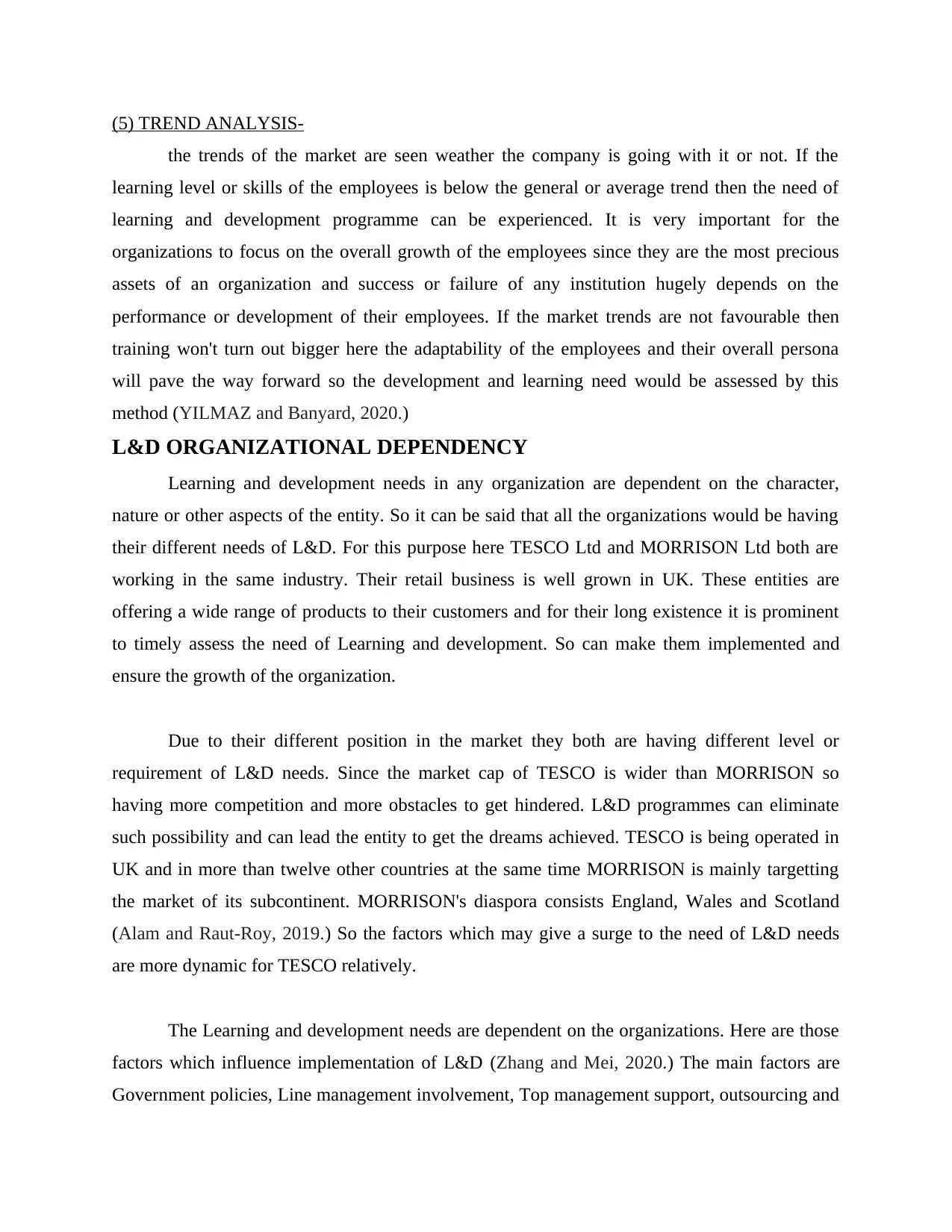
(5) TREND ANALYSIS-
the trends of the market are seen weather the company is going with it or not. If the
learning level or skills of the employees is below the general or average trend then the need of
learning and development programme can be experienced. It is very important for the
organizations to focus on the overall growth of the employees since they are the most precious
assets of an organization and success or failure of any institution hugely depends on the
performance or development of their employees. If the market trends are not favourable then
training won't turn out bigger here the adaptability of the employees and their overall persona
will pave the way forward so the development and learning need would be assessed by this
method (YILMAZ and Banyard, 2020.)
L&D ORGANIZATIONAL DEPENDENCY
Learning and development needs in any organization are dependent on the character,
nature or other aspects of the entity. So it can be said that all the organizations would be having
their different needs of L&D. For this purpose here TESCO Ltd and MORRISON Ltd both are
working in the same industry. Their retail business is well grown in UK. These entities are
offering a wide range of products to their customers and for their long existence it is prominent
to timely assess the need of Learning and development. So can make them implemented and
ensure the growth of the organization.
Due to their different position in the market they both are having different level or
requirement of L&D needs. Since the market cap of TESCO is wider than MORRISON so
having more competition and more obstacles to get hindered. L&D programmes can eliminate
such possibility and can lead the entity to get the dreams achieved. TESCO is being operated in
UK and in more than twelve other countries at the same time MORRISON is mainly targetting
the market of its subcontinent. MORRISON's diaspora consists England, Wales and Scotland
(Alam and Raut-Roy, 2019.) So the factors which may give a surge to the need of L&D needs
are more dynamic for TESCO relatively.
The Learning and development needs are dependent on the organizations. Here are those
factors which influence implementation of L&D (Zhang and Mei, 2020.) The main factors are
Government policies, Line management involvement, Top management support, outsourcing and
the trends of the market are seen weather the company is going with it or not. If the
learning level or skills of the employees is below the general or average trend then the need of
learning and development programme can be experienced. It is very important for the
organizations to focus on the overall growth of the employees since they are the most precious
assets of an organization and success or failure of any institution hugely depends on the
performance or development of their employees. If the market trends are not favourable then
training won't turn out bigger here the adaptability of the employees and their overall persona
will pave the way forward so the development and learning need would be assessed by this
method (YILMAZ and Banyard, 2020.)
L&D ORGANIZATIONAL DEPENDENCY
Learning and development needs in any organization are dependent on the character,
nature or other aspects of the entity. So it can be said that all the organizations would be having
their different needs of L&D. For this purpose here TESCO Ltd and MORRISON Ltd both are
working in the same industry. Their retail business is well grown in UK. These entities are
offering a wide range of products to their customers and for their long existence it is prominent
to timely assess the need of Learning and development. So can make them implemented and
ensure the growth of the organization.
Due to their different position in the market they both are having different level or
requirement of L&D needs. Since the market cap of TESCO is wider than MORRISON so
having more competition and more obstacles to get hindered. L&D programmes can eliminate
such possibility and can lead the entity to get the dreams achieved. TESCO is being operated in
UK and in more than twelve other countries at the same time MORRISON is mainly targetting
the market of its subcontinent. MORRISON's diaspora consists England, Wales and Scotland
(Alam and Raut-Roy, 2019.) So the factors which may give a surge to the need of L&D needs
are more dynamic for TESCO relatively.
The Learning and development needs are dependent on the organizations. Here are those
factors which influence implementation of L&D (Zhang and Mei, 2020.) The main factors are
Government policies, Line management involvement, Top management support, outsourcing and

external consultant etc. these factors are directly associated with the need of learning and
development. All the organization keep different purpose, aim, mission, objectives etc. which
creates difference in their requirements.
One side TESCO Ltd is a bigger organization which is not only based in UK and
conjoined countries but also working outside nation with around three lac employees having
more than two thousand stores. Majority of its labours are in Britain yet the global impacts can't
be ignored. The products of the entity are offering ample amount of choice to the customers and
with the time it is getting reshaped to meed the challenges of the business environment.
Specifically after uproar of the pandemics it got reshuffled and for faster recovery took a few
drastic steps. The company is well-known for the services it offers and the mission and
objectives it serves in favour of the well-being of all. As it has set the mission 'to be the
champion for customers'. Mission refers to the aim for long time and with this regard entity is
needed to build a strong base of employees (Rauf and Karjaluoto, 2019.)
On the other hand MORRISON is also getting operated in the same sector yet having
different mission and perspective. The mission of the company is 'To make and provide food'.
Due to limited market grasp the entity is serving limited amount of people compare to TESCO.
In MORRISON over one lac people are working which is one third of TESCO and having
around five hundred supermarkets and eleven million customers so both companies are operating
business with different features.
Learning and development is a wider phenomenon in which education, skills building,
training, attitude and aptitude, personal management are also included. It totally depends on the
organizational needs and their policies. In order to remain competitive in the sector TESCO has
adopted a well-articulated L&D program for the employees so can help them realize their
potential and as such increase the performance overall. Since it is globally working so having
greater diaspora of programmes (Minari, Brothers, and Morrison, 2018.) Different employees are
from different class, education, skills, nationality and many other factors so the company always
keeps this aspect in mind while implementing its programmes. As it is told TESCO is globally
development. All the organization keep different purpose, aim, mission, objectives etc. which
creates difference in their requirements.
One side TESCO Ltd is a bigger organization which is not only based in UK and
conjoined countries but also working outside nation with around three lac employees having
more than two thousand stores. Majority of its labours are in Britain yet the global impacts can't
be ignored. The products of the entity are offering ample amount of choice to the customers and
with the time it is getting reshaped to meed the challenges of the business environment.
Specifically after uproar of the pandemics it got reshuffled and for faster recovery took a few
drastic steps. The company is well-known for the services it offers and the mission and
objectives it serves in favour of the well-being of all. As it has set the mission 'to be the
champion for customers'. Mission refers to the aim for long time and with this regard entity is
needed to build a strong base of employees (Rauf and Karjaluoto, 2019.)
On the other hand MORRISON is also getting operated in the same sector yet having
different mission and perspective. The mission of the company is 'To make and provide food'.
Due to limited market grasp the entity is serving limited amount of people compare to TESCO.
In MORRISON over one lac people are working which is one third of TESCO and having
around five hundred supermarkets and eleven million customers so both companies are operating
business with different features.
Learning and development is a wider phenomenon in which education, skills building,
training, attitude and aptitude, personal management are also included. It totally depends on the
organizational needs and their policies. In order to remain competitive in the sector TESCO has
adopted a well-articulated L&D program for the employees so can help them realize their
potential and as such increase the performance overall. Since it is globally working so having
greater diaspora of programmes (Minari, Brothers, and Morrison, 2018.) Different employees are
from different class, education, skills, nationality and many other factors so the company always
keeps this aspect in mind while implementing its programmes. As it is told TESCO is globally
⊘ This is a preview!⊘
Do you want full access?
Subscribe today to unlock all pages.

Trusted by 1+ million students worldwide
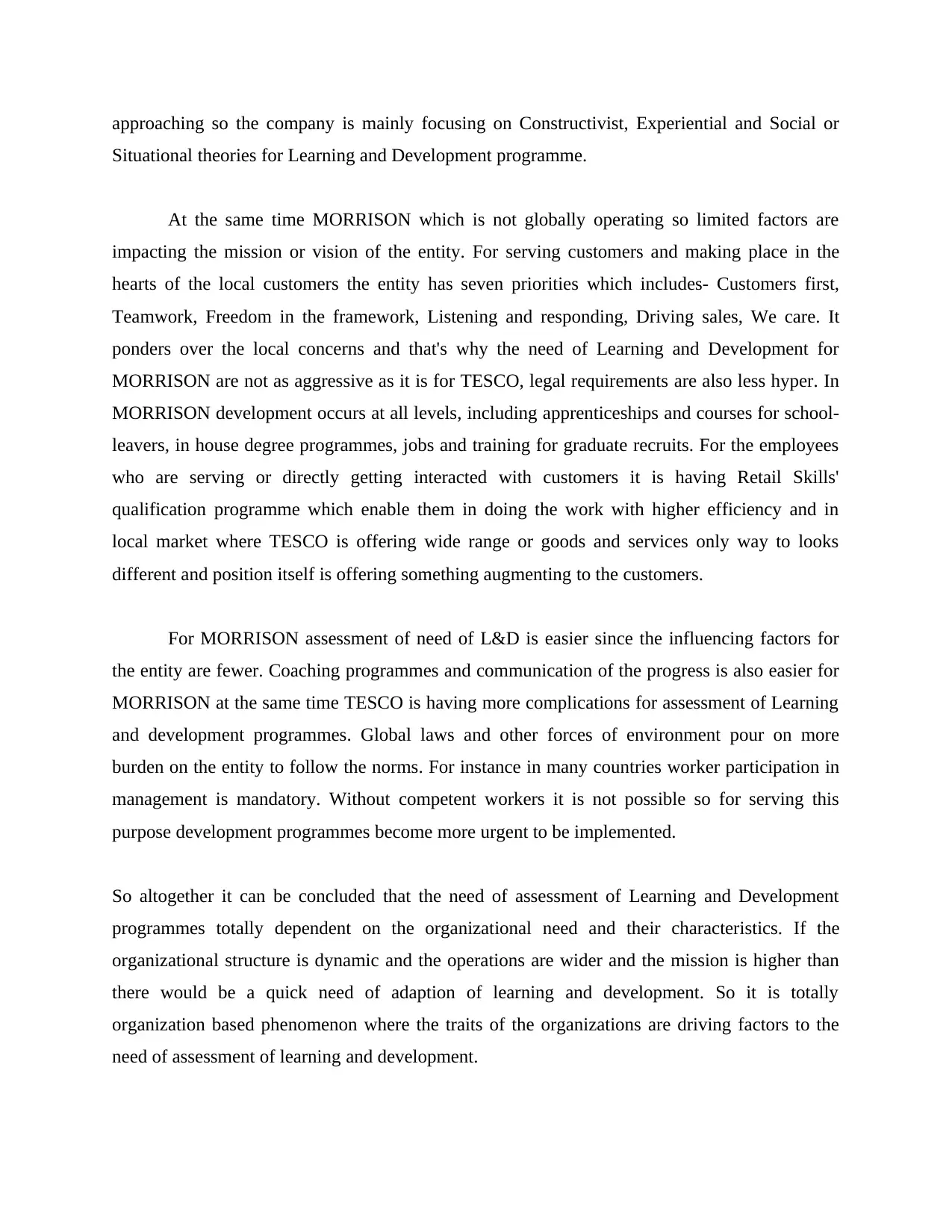
approaching so the company is mainly focusing on Constructivist, Experiential and Social or
Situational theories for Learning and Development programme.
At the same time MORRISON which is not globally operating so limited factors are
impacting the mission or vision of the entity. For serving customers and making place in the
hearts of the local customers the entity has seven priorities which includes- Customers first,
Teamwork, Freedom in the framework, Listening and responding, Driving sales, We care. It
ponders over the local concerns and that's why the need of Learning and Development for
MORRISON are not as aggressive as it is for TESCO, legal requirements are also less hyper. In
MORRISON development occurs at all levels, including apprenticeships and courses for school-
leavers, in house degree programmes, jobs and training for graduate recruits. For the employees
who are serving or directly getting interacted with customers it is having Retail Skills'
qualification programme which enable them in doing the work with higher efficiency and in
local market where TESCO is offering wide range or goods and services only way to looks
different and position itself is offering something augmenting to the customers.
For MORRISON assessment of need of L&D is easier since the influencing factors for
the entity are fewer. Coaching programmes and communication of the progress is also easier for
MORRISON at the same time TESCO is having more complications for assessment of Learning
and development programmes. Global laws and other forces of environment pour on more
burden on the entity to follow the norms. For instance in many countries worker participation in
management is mandatory. Without competent workers it is not possible so for serving this
purpose development programmes become more urgent to be implemented.
So altogether it can be concluded that the need of assessment of Learning and Development
programmes totally dependent on the organizational need and their characteristics. If the
organizational structure is dynamic and the operations are wider and the mission is higher than
there would be a quick need of adaption of learning and development. So it is totally
organization based phenomenon where the traits of the organizations are driving factors to the
need of assessment of learning and development.
Situational theories for Learning and Development programme.
At the same time MORRISON which is not globally operating so limited factors are
impacting the mission or vision of the entity. For serving customers and making place in the
hearts of the local customers the entity has seven priorities which includes- Customers first,
Teamwork, Freedom in the framework, Listening and responding, Driving sales, We care. It
ponders over the local concerns and that's why the need of Learning and Development for
MORRISON are not as aggressive as it is for TESCO, legal requirements are also less hyper. In
MORRISON development occurs at all levels, including apprenticeships and courses for school-
leavers, in house degree programmes, jobs and training for graduate recruits. For the employees
who are serving or directly getting interacted with customers it is having Retail Skills'
qualification programme which enable them in doing the work with higher efficiency and in
local market where TESCO is offering wide range or goods and services only way to looks
different and position itself is offering something augmenting to the customers.
For MORRISON assessment of need of L&D is easier since the influencing factors for
the entity are fewer. Coaching programmes and communication of the progress is also easier for
MORRISON at the same time TESCO is having more complications for assessment of Learning
and development programmes. Global laws and other forces of environment pour on more
burden on the entity to follow the norms. For instance in many countries worker participation in
management is mandatory. Without competent workers it is not possible so for serving this
purpose development programmes become more urgent to be implemented.
So altogether it can be concluded that the need of assessment of Learning and Development
programmes totally dependent on the organizational need and their characteristics. If the
organizational structure is dynamic and the operations are wider and the mission is higher than
there would be a quick need of adaption of learning and development. So it is totally
organization based phenomenon where the traits of the organizations are driving factors to the
need of assessment of learning and development.
Paraphrase This Document
Need a fresh take? Get an instant paraphrase of this document with our AI Paraphraser

IMPACTS ON ROI
Learning and development are directly related to the ability of an organization to generate
profits. Over the time it is experienced companies with higher L&D implementation and priority
are generating more revenues. But the fact can't be denied that all the companies are on their
different needs of L&D (Pan, 2018.) Here it can also be said that installation of L&D won't
impact all the entities similarly. There are number of methods are available for such assessment
but it totally depends on the entities to decide the method of their choice which can meet their
requirements. If an organization is green and did not achieve its potential then if it practices
L&D then will be getting better results compares to the entity which is already experiencing the
saturation stage.
If an entity practices organizational analysis method to assess the requirement of learning
and development then it would work differently. Here in this case if the method is being
followed by TESCO then due to vast approach, global presence and bigger constellation of
products it will show higher need of such programmes and the entity will practice it. Global
market is a bit riskier than the local market due to presence of more rigorous business
environment factors which also offers more possibility of generating revenues so in this case
such programmes may drive to the organization to have higher ROI. MORRISON which is
getting worked in the nation so this method will depict less need of such programme. For better
growth and to ace the mission L&D programmes can be installed. This is a local market player
and having less competition relatively so would be having low need of practician Learning and
development programme comparatively. As it is generally perceived the risk factors are lower
for the local players so the returns would also be lower. Implementation of such programmes will
not give it exponential growth to the Return On Investment (Deshpande, 2022.)
Performance analysis is the method which directly compares the actual and standard
performance so can eradicate the deviations by learning and development programmes. If we put
these facts together that at one side TESCO which is operating the business globally and having
different standards for different markets so there is huge possibility of having deviations.
Whereas MORRISON is working inside the boundary of nation so influencing factors are also
limited as compares to TESCO. Further it is also having local market where setting standards is
Learning and development are directly related to the ability of an organization to generate
profits. Over the time it is experienced companies with higher L&D implementation and priority
are generating more revenues. But the fact can't be denied that all the companies are on their
different needs of L&D (Pan, 2018.) Here it can also be said that installation of L&D won't
impact all the entities similarly. There are number of methods are available for such assessment
but it totally depends on the entities to decide the method of their choice which can meet their
requirements. If an organization is green and did not achieve its potential then if it practices
L&D then will be getting better results compares to the entity which is already experiencing the
saturation stage.
If an entity practices organizational analysis method to assess the requirement of learning
and development then it would work differently. Here in this case if the method is being
followed by TESCO then due to vast approach, global presence and bigger constellation of
products it will show higher need of such programmes and the entity will practice it. Global
market is a bit riskier than the local market due to presence of more rigorous business
environment factors which also offers more possibility of generating revenues so in this case
such programmes may drive to the organization to have higher ROI. MORRISON which is
getting worked in the nation so this method will depict less need of such programme. For better
growth and to ace the mission L&D programmes can be installed. This is a local market player
and having less competition relatively so would be having low need of practician Learning and
development programme comparatively. As it is generally perceived the risk factors are lower
for the local players so the returns would also be lower. Implementation of such programmes will
not give it exponential growth to the Return On Investment (Deshpande, 2022.)
Performance analysis is the method which directly compares the actual and standard
performance so can eradicate the deviations by learning and development programmes. If we put
these facts together that at one side TESCO which is operating the business globally and having
different standards for different markets so there is huge possibility of having deviations.
Whereas MORRISON is working inside the boundary of nation so influencing factors are also
limited as compares to TESCO. Further it is also having local market where setting standards is
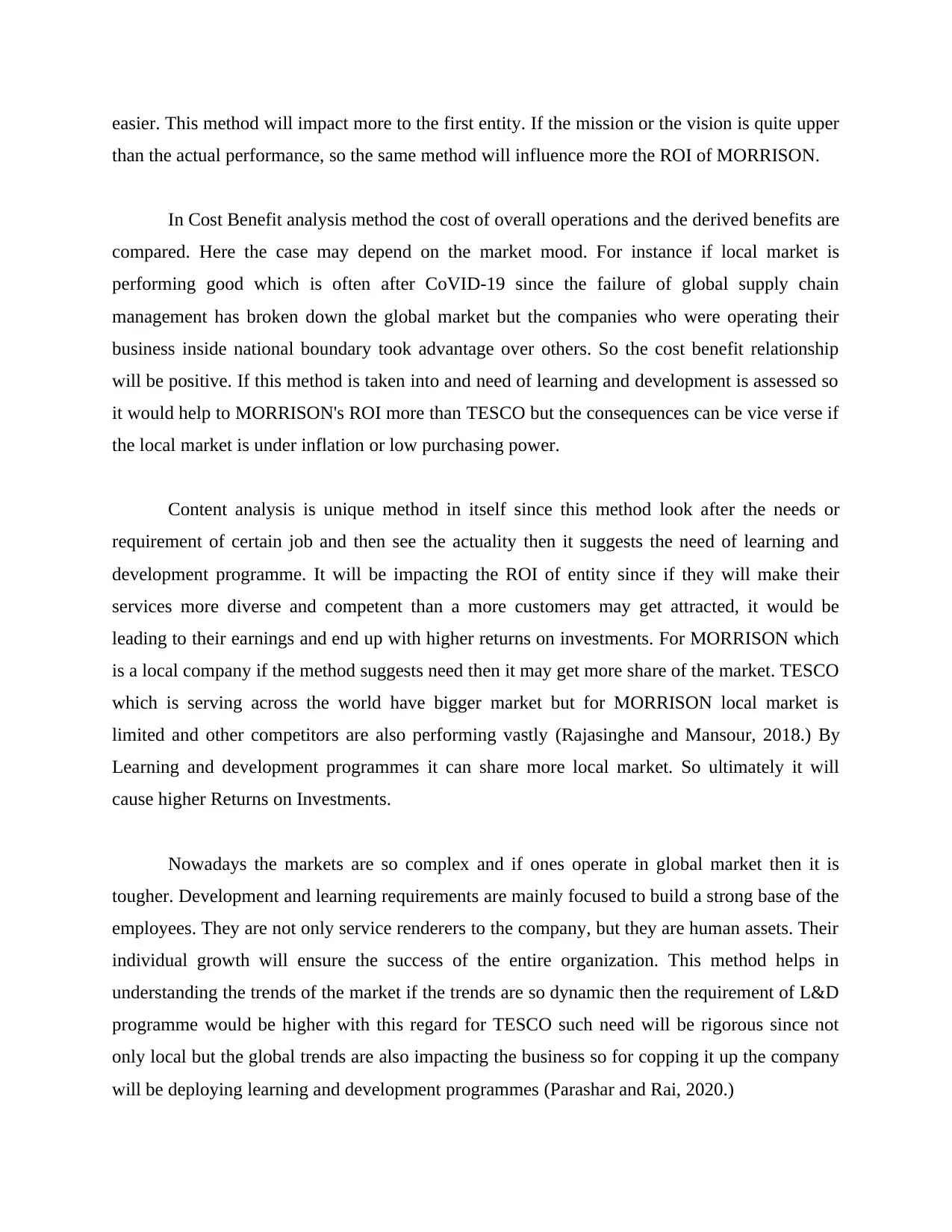
easier. This method will impact more to the first entity. If the mission or the vision is quite upper
than the actual performance, so the same method will influence more the ROI of MORRISON.
In Cost Benefit analysis method the cost of overall operations and the derived benefits are
compared. Here the case may depend on the market mood. For instance if local market is
performing good which is often after CoVID-19 since the failure of global supply chain
management has broken down the global market but the companies who were operating their
business inside national boundary took advantage over others. So the cost benefit relationship
will be positive. If this method is taken into and need of learning and development is assessed so
it would help to MORRISON's ROI more than TESCO but the consequences can be vice verse if
the local market is under inflation or low purchasing power.
Content analysis is unique method in itself since this method look after the needs or
requirement of certain job and then see the actuality then it suggests the need of learning and
development programme. It will be impacting the ROI of entity since if they will make their
services more diverse and competent than a more customers may get attracted, it would be
leading to their earnings and end up with higher returns on investments. For MORRISON which
is a local company if the method suggests need then it may get more share of the market. TESCO
which is serving across the world have bigger market but for MORRISON local market is
limited and other competitors are also performing vastly (Rajasinghe and Mansour, 2018.) By
Learning and development programmes it can share more local market. So ultimately it will
cause higher Returns on Investments.
Nowadays the markets are so complex and if ones operate in global market then it is
tougher. Development and learning requirements are mainly focused to build a strong base of the
employees. They are not only service renderers to the company, but they are human assets. Their
individual growth will ensure the success of the entire organization. This method helps in
understanding the trends of the market if the trends are so dynamic then the requirement of L&D
programme would be higher with this regard for TESCO such need will be rigorous since not
only local but the global trends are also impacting the business so for copping it up the company
will be deploying learning and development programmes (Parashar and Rai, 2020.)
than the actual performance, so the same method will influence more the ROI of MORRISON.
In Cost Benefit analysis method the cost of overall operations and the derived benefits are
compared. Here the case may depend on the market mood. For instance if local market is
performing good which is often after CoVID-19 since the failure of global supply chain
management has broken down the global market but the companies who were operating their
business inside national boundary took advantage over others. So the cost benefit relationship
will be positive. If this method is taken into and need of learning and development is assessed so
it would help to MORRISON's ROI more than TESCO but the consequences can be vice verse if
the local market is under inflation or low purchasing power.
Content analysis is unique method in itself since this method look after the needs or
requirement of certain job and then see the actuality then it suggests the need of learning and
development programme. It will be impacting the ROI of entity since if they will make their
services more diverse and competent than a more customers may get attracted, it would be
leading to their earnings and end up with higher returns on investments. For MORRISON which
is a local company if the method suggests need then it may get more share of the market. TESCO
which is serving across the world have bigger market but for MORRISON local market is
limited and other competitors are also performing vastly (Rajasinghe and Mansour, 2018.) By
Learning and development programmes it can share more local market. So ultimately it will
cause higher Returns on Investments.
Nowadays the markets are so complex and if ones operate in global market then it is
tougher. Development and learning requirements are mainly focused to build a strong base of the
employees. They are not only service renderers to the company, but they are human assets. Their
individual growth will ensure the success of the entire organization. This method helps in
understanding the trends of the market if the trends are so dynamic then the requirement of L&D
programme would be higher with this regard for TESCO such need will be rigorous since not
only local but the global trends are also impacting the business so for copping it up the company
will be deploying learning and development programmes (Parashar and Rai, 2020.)
⊘ This is a preview!⊘
Do you want full access?
Subscribe today to unlock all pages.

Trusted by 1+ million students worldwide
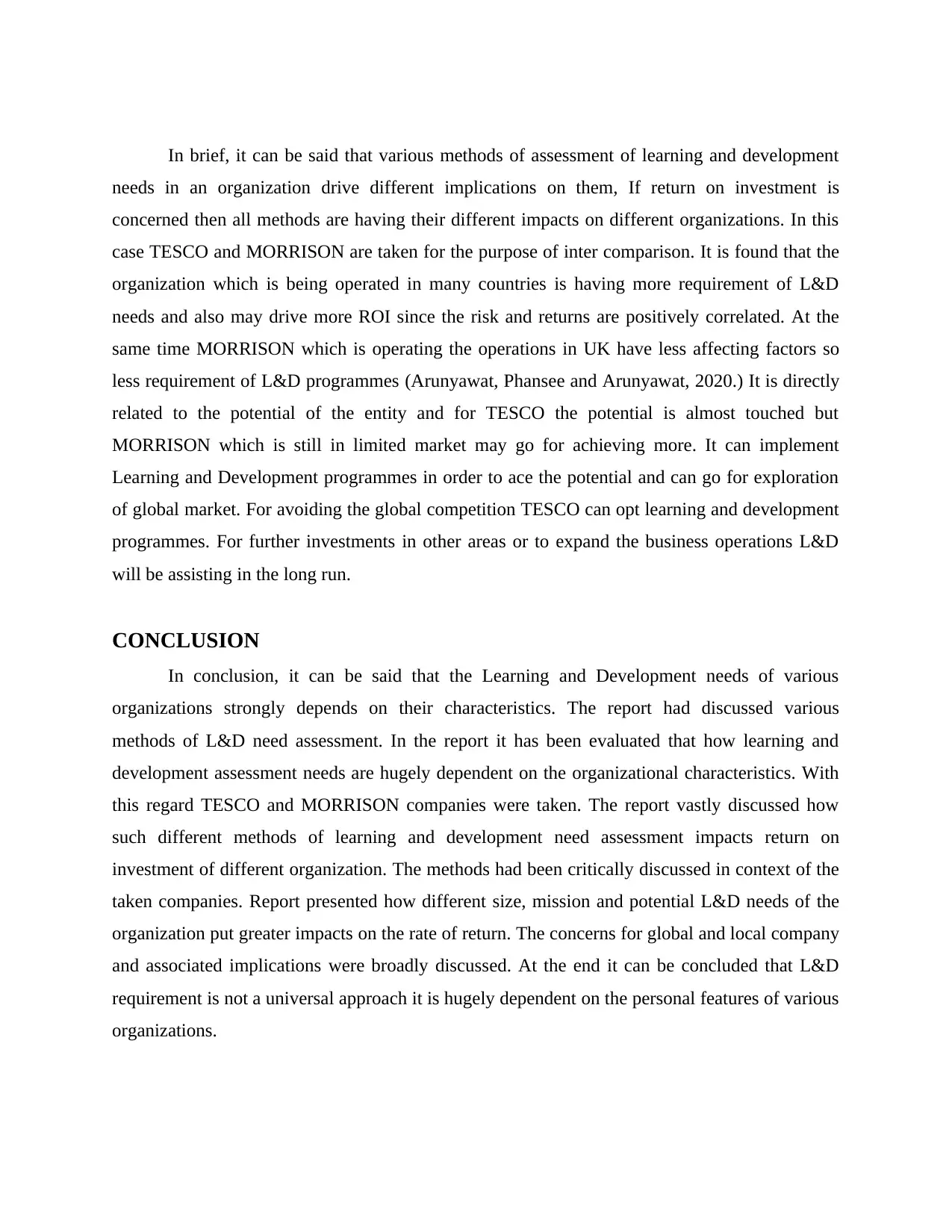
In brief, it can be said that various methods of assessment of learning and development
needs in an organization drive different implications on them, If return on investment is
concerned then all methods are having their different impacts on different organizations. In this
case TESCO and MORRISON are taken for the purpose of inter comparison. It is found that the
organization which is being operated in many countries is having more requirement of L&D
needs and also may drive more ROI since the risk and returns are positively correlated. At the
same time MORRISON which is operating the operations in UK have less affecting factors so
less requirement of L&D programmes (Arunyawat, Phansee and Arunyawat, 2020.) It is directly
related to the potential of the entity and for TESCO the potential is almost touched but
MORRISON which is still in limited market may go for achieving more. It can implement
Learning and Development programmes in order to ace the potential and can go for exploration
of global market. For avoiding the global competition TESCO can opt learning and development
programmes. For further investments in other areas or to expand the business operations L&D
will be assisting in the long run.
CONCLUSION
In conclusion, it can be said that the Learning and Development needs of various
organizations strongly depends on their characteristics. The report had discussed various
methods of L&D need assessment. In the report it has been evaluated that how learning and
development assessment needs are hugely dependent on the organizational characteristics. With
this regard TESCO and MORRISON companies were taken. The report vastly discussed how
such different methods of learning and development need assessment impacts return on
investment of different organization. The methods had been critically discussed in context of the
taken companies. Report presented how different size, mission and potential L&D needs of the
organization put greater impacts on the rate of return. The concerns for global and local company
and associated implications were broadly discussed. At the end it can be concluded that L&D
requirement is not a universal approach it is hugely dependent on the personal features of various
organizations.
needs in an organization drive different implications on them, If return on investment is
concerned then all methods are having their different impacts on different organizations. In this
case TESCO and MORRISON are taken for the purpose of inter comparison. It is found that the
organization which is being operated in many countries is having more requirement of L&D
needs and also may drive more ROI since the risk and returns are positively correlated. At the
same time MORRISON which is operating the operations in UK have less affecting factors so
less requirement of L&D programmes (Arunyawat, Phansee and Arunyawat, 2020.) It is directly
related to the potential of the entity and for TESCO the potential is almost touched but
MORRISON which is still in limited market may go for achieving more. It can implement
Learning and Development programmes in order to ace the potential and can go for exploration
of global market. For avoiding the global competition TESCO can opt learning and development
programmes. For further investments in other areas or to expand the business operations L&D
will be assisting in the long run.
CONCLUSION
In conclusion, it can be said that the Learning and Development needs of various
organizations strongly depends on their characteristics. The report had discussed various
methods of L&D need assessment. In the report it has been evaluated that how learning and
development assessment needs are hugely dependent on the organizational characteristics. With
this regard TESCO and MORRISON companies were taken. The report vastly discussed how
such different methods of learning and development need assessment impacts return on
investment of different organization. The methods had been critically discussed in context of the
taken companies. Report presented how different size, mission and potential L&D needs of the
organization put greater impacts on the rate of return. The concerns for global and local company
and associated implications were broadly discussed. At the end it can be concluded that L&D
requirement is not a universal approach it is hugely dependent on the personal features of various
organizations.
Paraphrase This Document
Need a fresh take? Get an instant paraphrase of this document with our AI Paraphraser
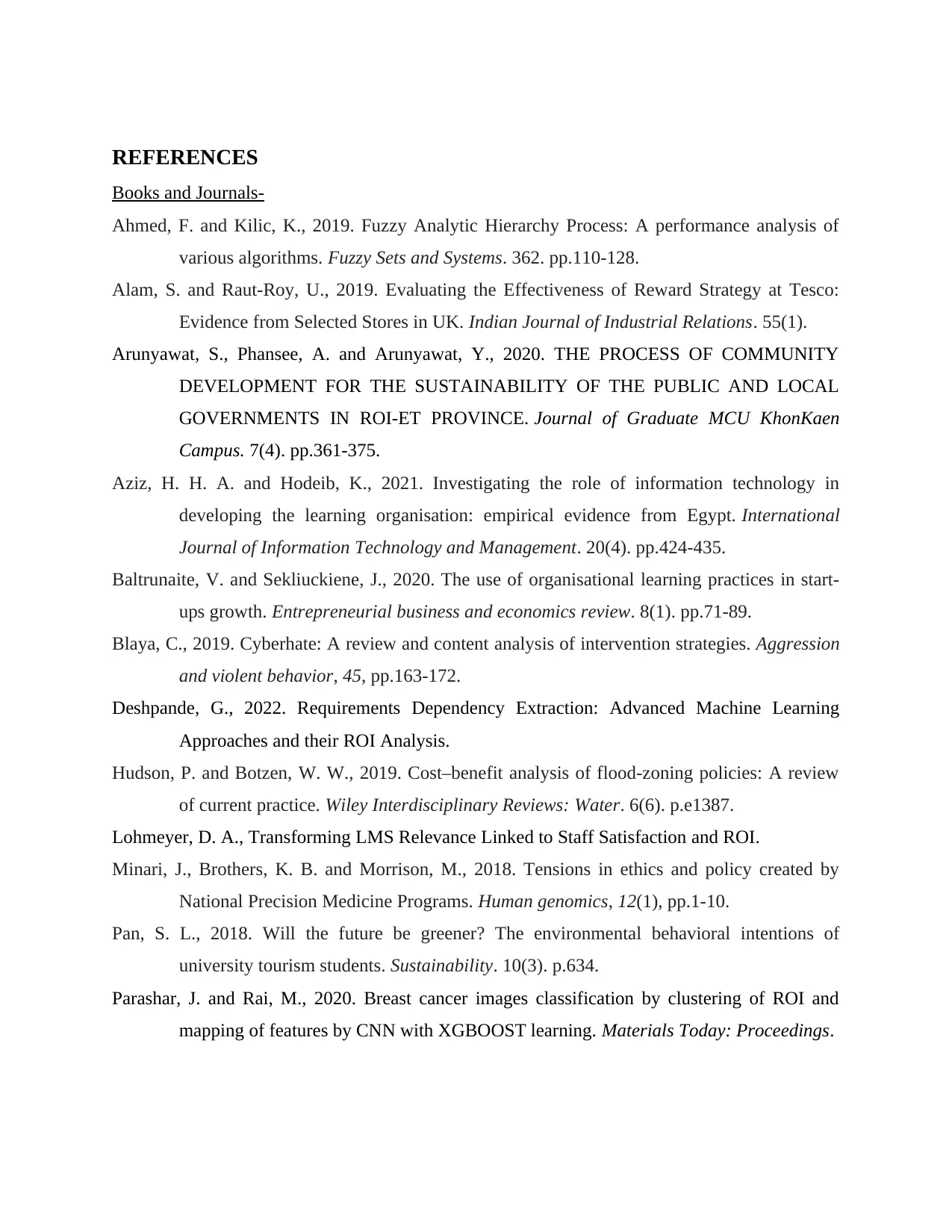
REFERENCES
Books and Journals-
Ahmed, F. and Kilic, K., 2019. Fuzzy Analytic Hierarchy Process: A performance analysis of
various algorithms. Fuzzy Sets and Systems. 362. pp.110-128.
Alam, S. and Raut-Roy, U., 2019. Evaluating the Effectiveness of Reward Strategy at Tesco:
Evidence from Selected Stores in UK. Indian Journal of Industrial Relations. 55(1).
Arunyawat, S., Phansee, A. and Arunyawat, Y., 2020. THE PROCESS OF COMMUNITY
DEVELOPMENT FOR THE SUSTAINABILITY OF THE PUBLIC AND LOCAL
GOVERNMENTS IN ROI-ET PROVINCE. Journal of Graduate MCU KhonKaen
Campus. 7(4). pp.361-375.
Aziz, H. H. A. and Hodeib, K., 2021. Investigating the role of information technology in
developing the learning organisation: empirical evidence from Egypt. International
Journal of Information Technology and Management. 20(4). pp.424-435.
Baltrunaite, V. and Sekliuckiene, J., 2020. The use of organisational learning practices in start-
ups growth. Entrepreneurial business and economics review. 8(1). pp.71-89.
Blaya, C., 2019. Cyberhate: A review and content analysis of intervention strategies. Aggression
and violent behavior, 45, pp.163-172.
Deshpande, G., 2022. Requirements Dependency Extraction: Advanced Machine Learning
Approaches and their ROI Analysis.
Hudson, P. and Botzen, W. W., 2019. Cost–benefit analysis of flood‐zoning policies: A review
of current practice. Wiley Interdisciplinary Reviews: Water. 6(6). p.e1387.
Lohmeyer, D. A., Transforming LMS Relevance Linked to Staff Satisfaction and ROI.
Minari, J., Brothers, K. B. and Morrison, M., 2018. Tensions in ethics and policy created by
National Precision Medicine Programs. Human genomics, 12(1), pp.1-10.
Pan, S. L., 2018. Will the future be greener? The environmental behavioral intentions of
university tourism students. Sustainability. 10(3). p.634.
Parashar, J. and Rai, M., 2020. Breast cancer images classification by clustering of ROI and
mapping of features by CNN with XGBOOST learning. Materials Today: Proceedings.
Books and Journals-
Ahmed, F. and Kilic, K., 2019. Fuzzy Analytic Hierarchy Process: A performance analysis of
various algorithms. Fuzzy Sets and Systems. 362. pp.110-128.
Alam, S. and Raut-Roy, U., 2019. Evaluating the Effectiveness of Reward Strategy at Tesco:
Evidence from Selected Stores in UK. Indian Journal of Industrial Relations. 55(1).
Arunyawat, S., Phansee, A. and Arunyawat, Y., 2020. THE PROCESS OF COMMUNITY
DEVELOPMENT FOR THE SUSTAINABILITY OF THE PUBLIC AND LOCAL
GOVERNMENTS IN ROI-ET PROVINCE. Journal of Graduate MCU KhonKaen
Campus. 7(4). pp.361-375.
Aziz, H. H. A. and Hodeib, K., 2021. Investigating the role of information technology in
developing the learning organisation: empirical evidence from Egypt. International
Journal of Information Technology and Management. 20(4). pp.424-435.
Baltrunaite, V. and Sekliuckiene, J., 2020. The use of organisational learning practices in start-
ups growth. Entrepreneurial business and economics review. 8(1). pp.71-89.
Blaya, C., 2019. Cyberhate: A review and content analysis of intervention strategies. Aggression
and violent behavior, 45, pp.163-172.
Deshpande, G., 2022. Requirements Dependency Extraction: Advanced Machine Learning
Approaches and their ROI Analysis.
Hudson, P. and Botzen, W. W., 2019. Cost–benefit analysis of flood‐zoning policies: A review
of current practice. Wiley Interdisciplinary Reviews: Water. 6(6). p.e1387.
Lohmeyer, D. A., Transforming LMS Relevance Linked to Staff Satisfaction and ROI.
Minari, J., Brothers, K. B. and Morrison, M., 2018. Tensions in ethics and policy created by
National Precision Medicine Programs. Human genomics, 12(1), pp.1-10.
Pan, S. L., 2018. Will the future be greener? The environmental behavioral intentions of
university tourism students. Sustainability. 10(3). p.634.
Parashar, J. and Rai, M., 2020. Breast cancer images classification by clustering of ROI and
mapping of features by CNN with XGBOOST learning. Materials Today: Proceedings.
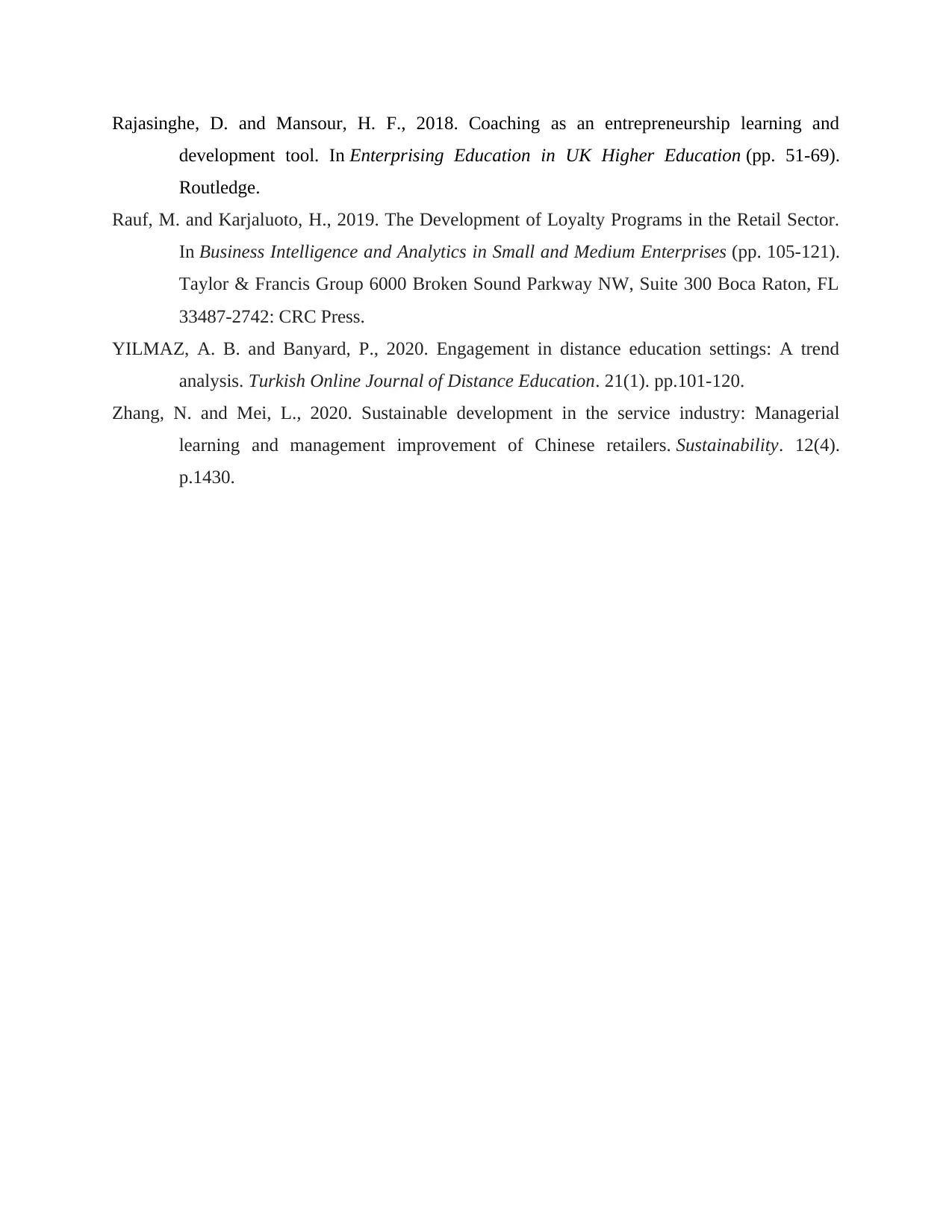
Rajasinghe, D. and Mansour, H. F., 2018. Coaching as an entrepreneurship learning and
development tool. In Enterprising Education in UK Higher Education (pp. 51-69).
Routledge.
Rauf, M. and Karjaluoto, H., 2019. The Development of Loyalty Programs in the Retail Sector.
In Business Intelligence and Analytics in Small and Medium Enterprises (pp. 105-121).
Taylor & Francis Group 6000 Broken Sound Parkway NW, Suite 300 Boca Raton, FL
33487-2742: CRC Press.
YILMAZ, A. B. and Banyard, P., 2020. Engagement in distance education settings: A trend
analysis. Turkish Online Journal of Distance Education. 21(1). pp.101-120.
Zhang, N. and Mei, L., 2020. Sustainable development in the service industry: Managerial
learning and management improvement of Chinese retailers. Sustainability. 12(4).
p.1430.
development tool. In Enterprising Education in UK Higher Education (pp. 51-69).
Routledge.
Rauf, M. and Karjaluoto, H., 2019. The Development of Loyalty Programs in the Retail Sector.
In Business Intelligence and Analytics in Small and Medium Enterprises (pp. 105-121).
Taylor & Francis Group 6000 Broken Sound Parkway NW, Suite 300 Boca Raton, FL
33487-2742: CRC Press.
YILMAZ, A. B. and Banyard, P., 2020. Engagement in distance education settings: A trend
analysis. Turkish Online Journal of Distance Education. 21(1). pp.101-120.
Zhang, N. and Mei, L., 2020. Sustainable development in the service industry: Managerial
learning and management improvement of Chinese retailers. Sustainability. 12(4).
p.1430.
⊘ This is a preview!⊘
Do you want full access?
Subscribe today to unlock all pages.

Trusted by 1+ million students worldwide
1 out of 13
Related Documents
Your All-in-One AI-Powered Toolkit for Academic Success.
+13062052269
info@desklib.com
Available 24*7 on WhatsApp / Email
![[object Object]](/_next/static/media/star-bottom.7253800d.svg)
Unlock your academic potential
Copyright © 2020–2025 A2Z Services. All Rights Reserved. Developed and managed by ZUCOL.





